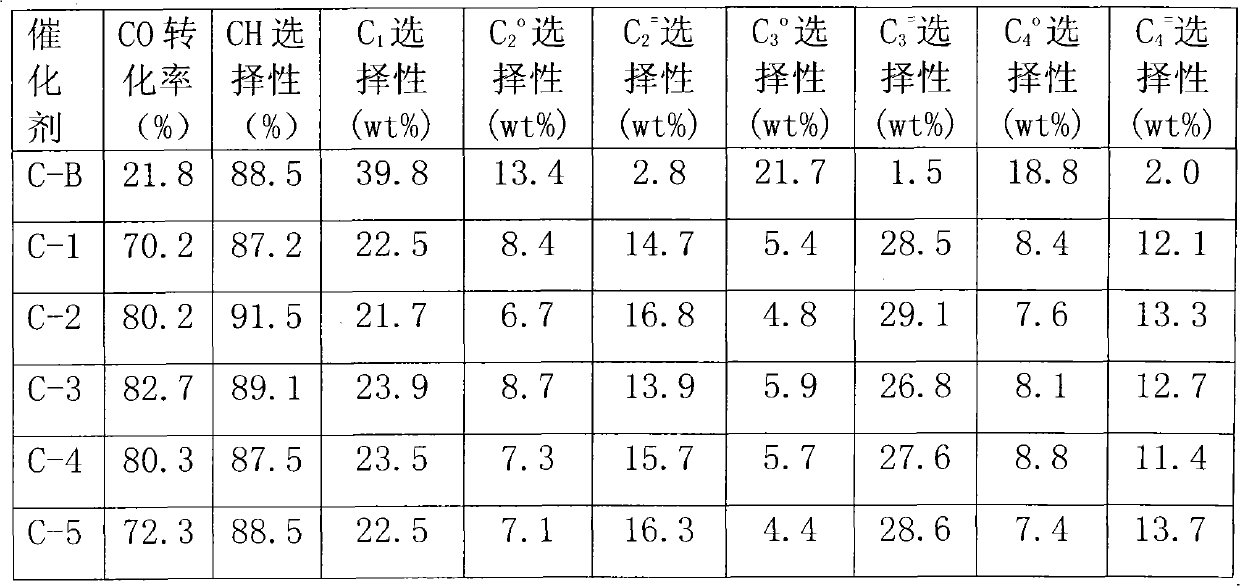Method for preparing low-carbon olefine catalyst by loading iron-based synthetic gas
A low-carbon olefin and catalyst technology, which is applied in the field of preparing a supported iron-based synthesis gas to low-carbon olefin catalyst, can solve the problems of difficulty in achieving reaction activity, high catalyst cost, low CO conversion rate, etc., and achieves high mechanical strength. , the preparation method is simple, the effect of improving the activity
- Summary
- Abstract
- Description
- Claims
- Application Information
AI Technical Summary
Problems solved by technology
Method used
Image
Examples
example 1
[0018] Weigh commercially available silica gel (pore volume is 1.06ml / g, specific surface area is 386.81m 2 / g, the following examples all use the silica gel) 30g, distilled water is added dropwise to initial moistening, the volume of consumed water is 48ml, 48ml concentration is 20% pyridine solution, add in silica gel at 50 ℃, process 10 hours. Dry at 60°C for 24 hours, then bake at 280°C for 15 hours. Based on the final catalyst K content of 0.023wt%, weigh 0.0179g of potassium nitrate and add distilled water to 48g, add the above-mentioned modified carrier silica gel for impregnation, dry at 60°C for 24 hours, and bake at 350°C for 10 hours. Based on the final catalyst Fe content of 3wt%, weigh 6.6303g of ferric nitrate and add distilled water to 48g, add to the above-mentioned sample impregnated with potassium, dry at 60°C for 24 hours, and bake at 350°C for 10 hours in vacuum or nitrogen atmosphere. Based on the final catalyst manganese content of 1.06wt%, weigh 2.0716g...
example 2
[0021] Weigh 30g of commercially available silica gel, add distilled water dropwise until initial moistening, the volume of consumed water is 48ml, add 48ml of 15% diethanolamine solution into the silica gel at 80°C, and stir. Treat for 30 hours and dry at 90°C for 16 hours. According to the final catalyst K content of 0.39wt%, weigh 0.3042g of potassium nitrate, add distilled water to 48g, add the above-mentioned modified carrier silica gel to impregnate, dry at 100°C for 16 hours, and roast in vacuum or nitrogen atmosphere at 550°C for 4 Hour. Based on the final catalyst Fe content of 9wt%, weigh 19.8909g of ferric nitrate, add distilled water to 48g, add the above-mentioned potassium-impregnated sample, dry at 100°C for 16 hours, and bake in vacuum or nitrogen atmosphere at 550°C for 4 hours. Based on the final catalyst manganese content of 3.6wt%, weigh 7.0355g of 50% manganese nitrate solution, add distilled water to 48g, add the above sample impregnated with potassium a...
example 3
[0023]Weigh 30g of commercially available silica gel, add distilled water dropwise until initial moistening, the volume of consumed water is 48ml, add 48ml of 5% ethanolamine solution to the silica gel at 95°C, stir for 100 hours, and dry at 100°C for 8 hours. Based on the final catalyst K content of 0.8wt%, 0.624g of potassium nitrate was weighed and dissolved in 48ml, added to the modified carrier silica gel for impregnation, dried at 150°C for 8 hours, and roasted at 700°C for 2 hours in vacuum or nitrogen atmosphere. Based on the final catalyst Fe content of 12wt%, 26.5212g of iron nitrate was weighed and dissolved in 48ml, added to the above-mentioned sample impregnated with potassium, dried at 150°C for 8 hours, and roasted in vacuum or nitrogen atmosphere at 700°C for 2 hours. Based on the final catalyst manganese content of 5.44wt%, weigh 10.6315g of 50% manganese nitrate solution, add water to 48g, add the above sample impregnated with potassium and iron, age for 3 hou...
PUM
 Login to View More
Login to View More Abstract
Description
Claims
Application Information
 Login to View More
Login to View More - R&D
- Intellectual Property
- Life Sciences
- Materials
- Tech Scout
- Unparalleled Data Quality
- Higher Quality Content
- 60% Fewer Hallucinations
Browse by: Latest US Patents, China's latest patents, Technical Efficacy Thesaurus, Application Domain, Technology Topic, Popular Technical Reports.
© 2025 PatSnap. All rights reserved.Legal|Privacy policy|Modern Slavery Act Transparency Statement|Sitemap|About US| Contact US: help@patsnap.com


